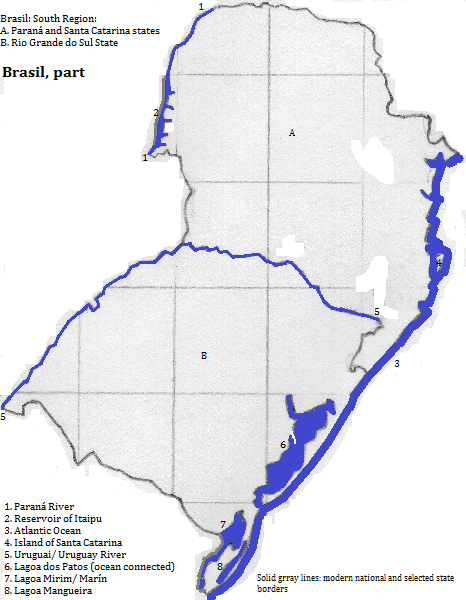
| To Duval Family Home Page | South America |
| To Chris Home Page | Brasil |
| To Earth (Geography Home Page) |
Most of this area is in Brazil's Central Highlands. A band of lowlands in Paraná, Santa Catarina
The Mountains of the Sea
The two rivers of the Plata River
A lagoon, Lagoa dos Patos,
UNESCO World Heritage Sites that honor nature are: the 'Atlantic Forest South-East Reserves, which crosses the regional boundary into Sâo Paulo State; and Iguaçu National Park, which is next to the city, 'Foz de Iguaçu, and is also a tourist attraction.

Unlike the rest of Brazil, less than 95% speak Portuguese. Over one in twenty speak German. And while Christianity remains an overwhelming characteristic, many of the German-speakers, and even some Portuguese-speaking people of German descent, practice Protestantism rather than Roman Catholicism.
There are two cities with over a million residents. Porto Alegre is the largest city with 4.006 million metropolitan residents.
Other cities of note include: Florianópolis, Navegantes, Londrina, Paranaguá, Foz do Iguaçu and Rio Grande.
UNESCO honors as a World Heritage Site 'Jesuit Missions of the Guaronis: San Ignacio Miní Santa Ana,, Nuestra Señora de Loreto and Santa Maria Mayor (Argentina), Ruins of São Miguel das Missiõnes (Brazil),' part of which is in the neighboring country.
So little was recorded at early Luzo-Brazilian contact, and so much change has been wrought since, that the best way to reconstruct the pre-Columbian past is to generalize from the present day distribution of indiginous languages, but this is admittedly error prone.
The three language groups represented by extant or known extinct languages are Tupi--specifically Tupi-Guarani; Macro-Ge--specifically Kaingang; and Awawakan.
Portuguese speakers began arriving in the 16th century and indiginous populations dwindled from disease and slavery. Large numbers of slaves were brought from Africa. Most indiginous and Afro-Brazilian people adopted Roman Catholic Christianity, and many indiginous and all Afro-Brazilian people switched their family language to Portuguese. The Afro-Brazilian version of Catholicism includes elements of the Vodun Religion of west Africa but its adherants regard themselves as pure Catholics.
Germans arrived in the decades surrounding the beginning of the 20th century along with other Europeans and Asians. While outnumbered by other immigrant groups, more of them went south instead of to São Paulo,
northeast
east
southwest
northwest of Rio Grande do Sul and Santa Catarina
west of southern Paraná
northwest of Paraná
1. Sul in Portuguese. Consists of Paraná, Rio Grande do Sul and Santa Catarina.
2. Officially Brasil since the late 19th century. In English, Brazil
3. Translates from Portuguese as Saint Katherine or Catherine or Kathryn or Kathleen.
4. Rio Grande do Sul translates from Portuguese as Big Southern River.
5. Sierra do Mar in Portuguese.
6. Sierra Geral ranslates as Common Mountains.
7. Rio de la Plata translates from Spanish as Silver River.
8. South America's second largest river, the ninth in the world.
9. Uruguay in Spanish and English.
10. Translates as 'Lagoon of the Ducks' from Portuguese, although lagoon is an inexact match.
11. Rio translates as river from Portuguese.
12. http://www.touropia.com/tourist-attractions-in-brazil/, accessed August 31, 2015.
13. 2012 figure from world-gazetteer.com, accessed February 6, 2016.
14. Joseph Greenberg classifies all three groups together with many others as Amerindian.
15. Translates from Portuguese as Saint Paul.